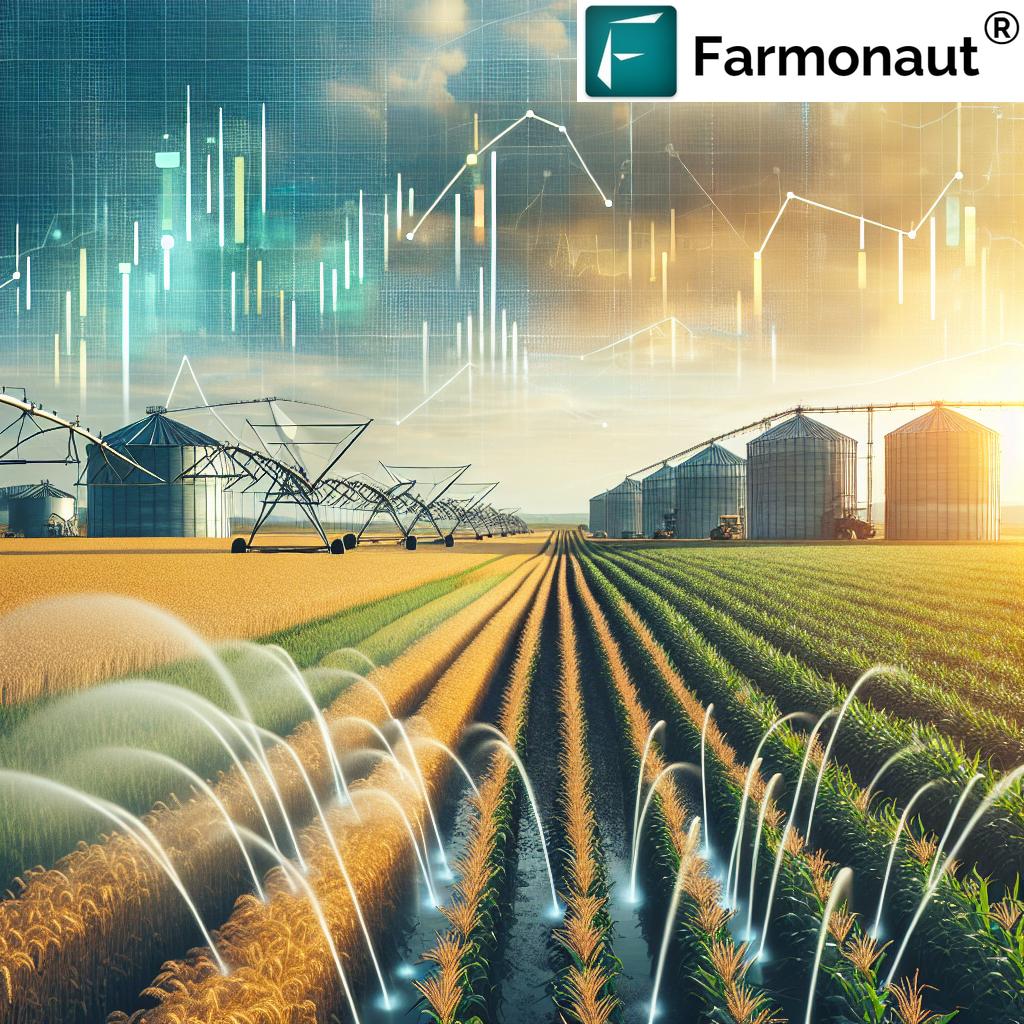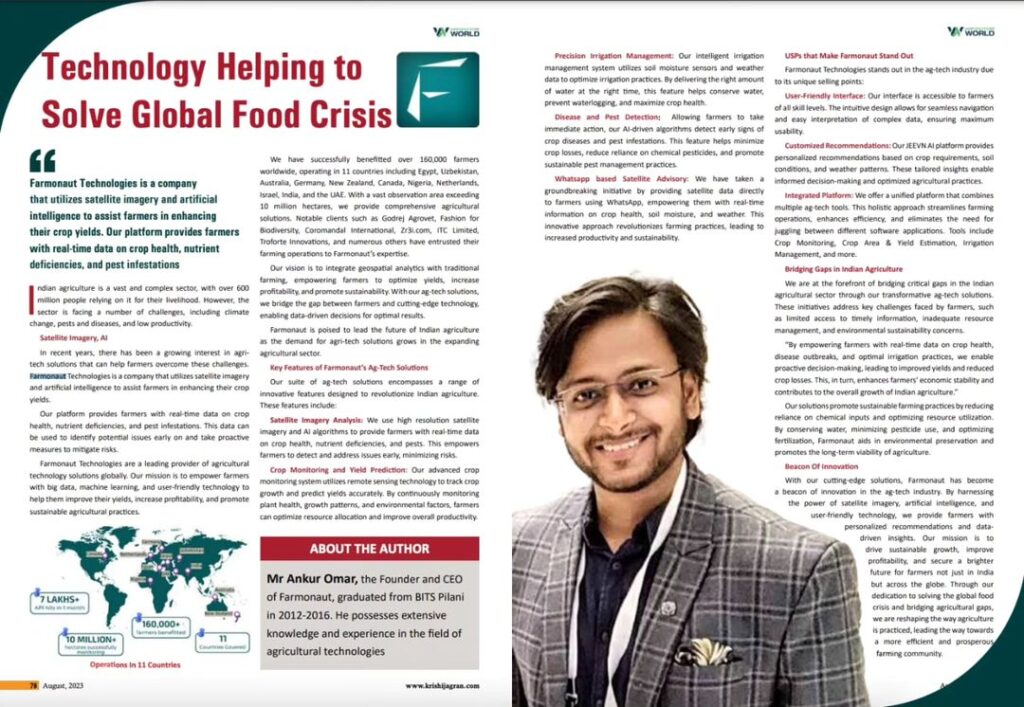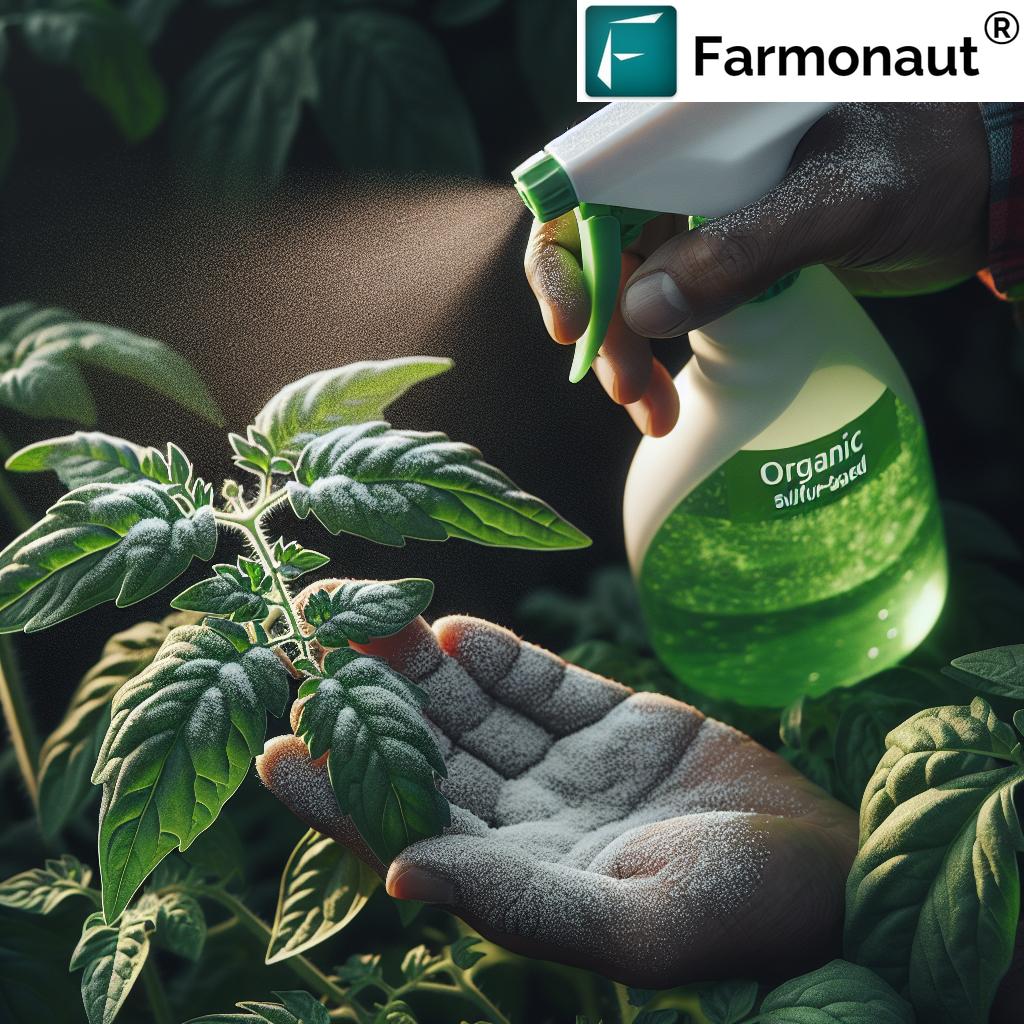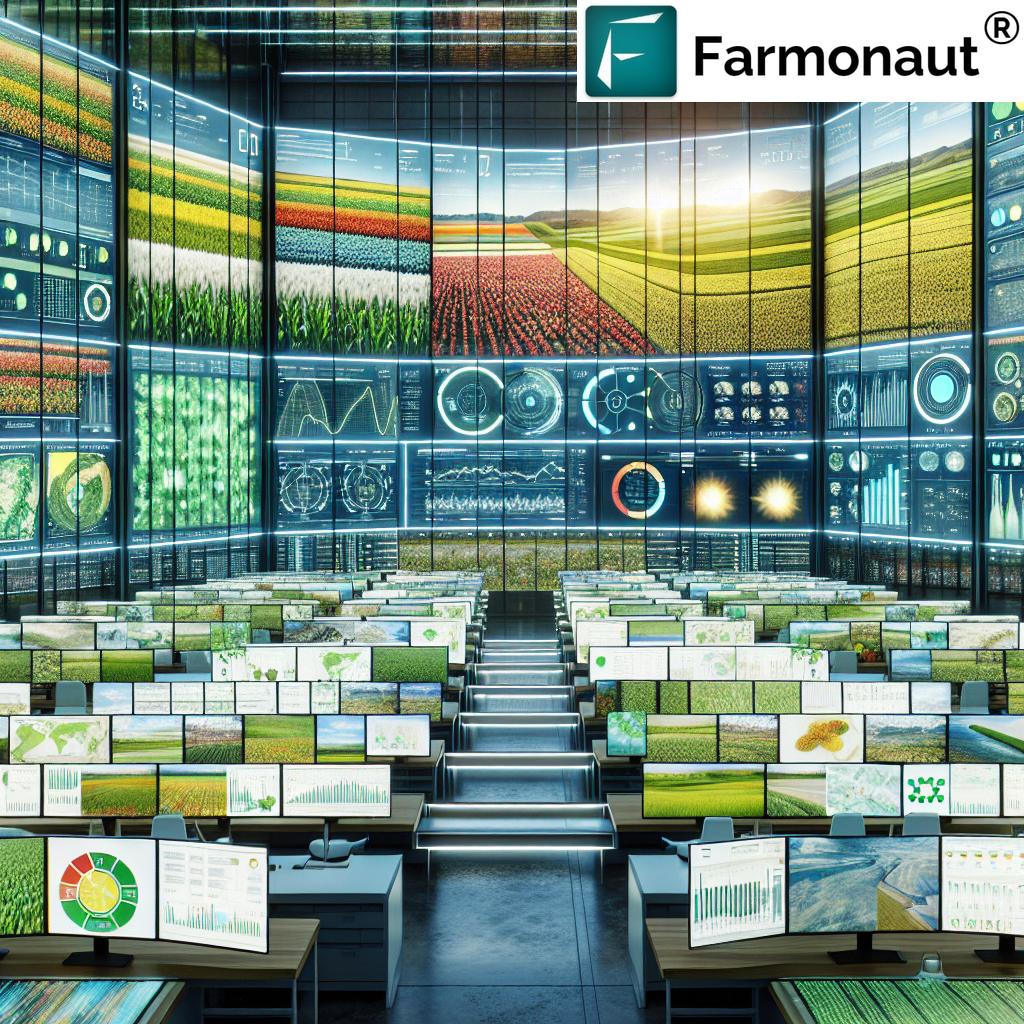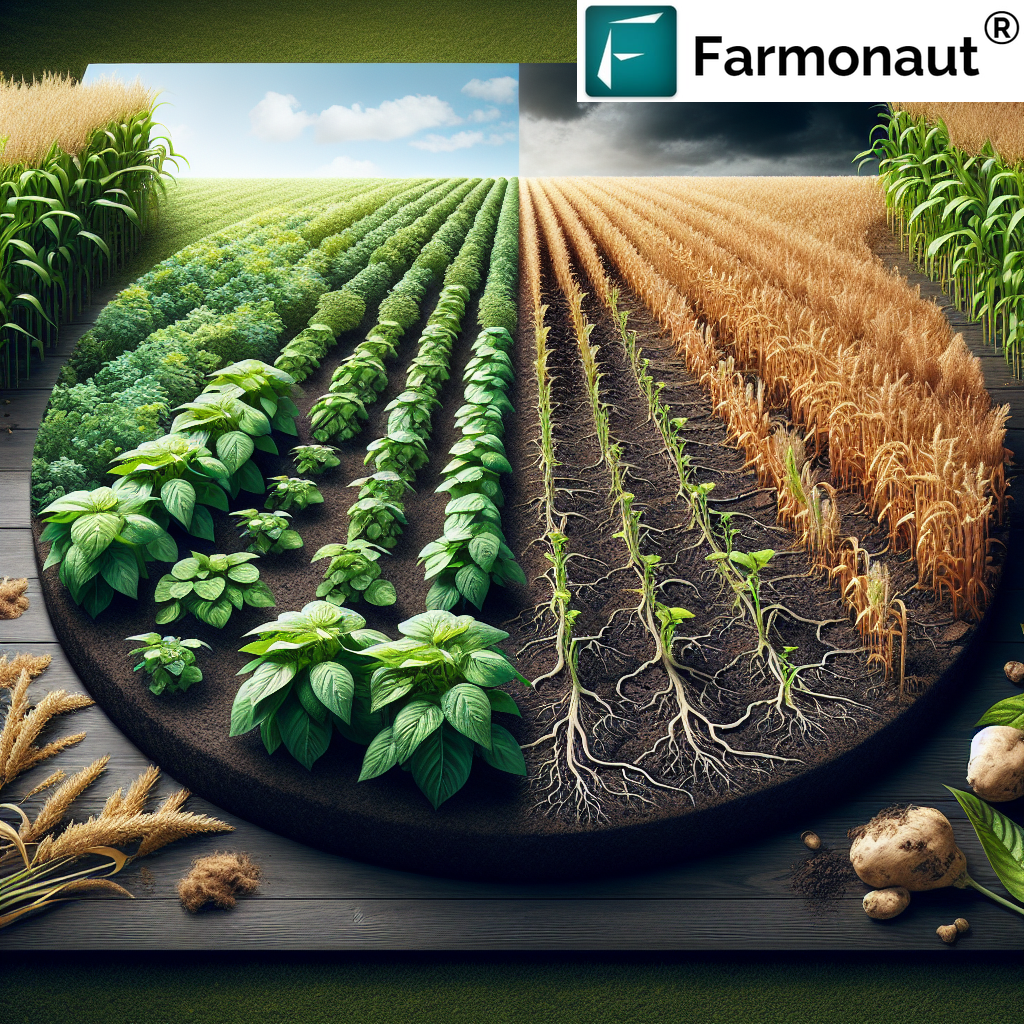Best Potato Farming Techniques in 2025: Enhancing Yield and Sustainability
“Precision soil management in 2025 can boost potato yields by up to 25% compared to traditional methods.”
Table of Contents
- Introduction: The Critical Role of Potato Farming
- Selection of Certified Seed Tubers: Foundation of Success
- Precision Land Preparation and Soil Management
- Advanced Irrigation Techniques for 2025
- Integrated Pest and Disease Management (IPDM)
- Nutrient Management and Fertilization Strategies
- Smart Harvesting and Post-Harvest Handling
- Embracing Sustainability and Climate Adaptation
- Comparative Table: Modern Potato Farming Innovations
- Farmonaut’s Satellite Technology: Empowering Precision Potato Farming
- Frequently Asked Questions (FAQs)
- Conclusion: Paving the Path for Potato Farming in 2025
Introduction: The Critical Role of Potato Farming
Potato (Solanum tuberosum) farming remains a critical component of global agriculture, providing an indispensable staple food source and economic livelihood for millions of farmers worldwide. This resilient crop’s importance only grows as we step into 2025, with dynamic climatic shifts and growing food demands spotlighting the best potato farming techniques.
Advancements in technology, sustainable agriculture, and precision management have significantly transformed potato cultivation. Modern approaches help maximize yield, improve crop quality, and ensure environmental sustainability to support thriving communities and guarantee food security. This article explores contemporary and effective methods to optimize potato farming in 2025, using latest strategies in soil management, irrigation, disease and pest control, and digital technologies for yield and sustainability.
Selection of Certified Seed Tubers: Foundation of Success
The foundation of any successful potato crop always begins with the right seed tubers. High-quality, certified seeds are essential because they drastically reduce risk of pests, pathogens, and eventual yield losses. In 2025, farmers have improved access to disease-free seeds through agricultural extension services and certified nurseries. Such improved varieties are vital for handling:
- Disease resistance: Varieties with traits like resistance to late blight & other potato diseases.
- Climatic adaptation: Seeds bred for tolerance to drought, heat, and shifting environmental conditions.
- Optimum performance: Tubers selected for high yield, rapid growth, and market-friendly qualities.
Key practices for seed tuber selection:
- Use certified, disease-free potato seeds only.
- Select varieties suited to local climate and soil conditions for better adaptation and resilience.
- Avoid using tubers from previous crops, as this can transfer pathogens and lead to failures.
- Store seeds in cool, dry, and ventilated conditions to maintain seed health.
This ensures that the crop has a robust foundation to thrive and can maximize yield right from the start.
Precision Land Preparation and Soil Management: Best Potato Farming Techniques for 2025
Modern potato farming hinges on precision land preparation and soil management. Potatoes require loose, fertile soils with excellent drainage and a slightly acidic pH (5.5–6.5). In 2025, technology makes it easier to deliver the exact practices that maximize tuber development, reduce resource wastage, and enhance yield.
Steps in Modern Precision Land Preparation
- GPS-guided machinery: Automated tractors with GPS-enablement allow plowing, ridging, and furrowing with precise even spacing, optimal soil aeration, and uniformity, boosting root and tuber health.
- Soil testing and mapping: Soil sensors and advanced digital tools evaluate nutrients, structure, and moisture levels before planting, ensuring bespoke plans for fertilization and irrigation.
- Organic matter incorporation: Addition of compost, green manure, or crop residues improves soil structure, increases moisture retention, and boosts soil health for resilient tubers.
- Crop rotation with legumes: Rotating with beans or cereals not only breaks disease cycles but also improves natural soil fertility.
These best potato farming techniques collectively ensure a robust, sustainable beginning for every crop season.
“Adoption of advanced pest control strategies reduced potato crop losses by 40% in technologically equipped farms by 2024.”
Best Practices for Potato Soil Management
- Assess and tailor fertilization: Start with soil testing to customize fertilizer types and doses, preventing imbalances and reducing overuse that could degrade soil health.
- Enhance drainage and structure: Regular furrowing and ridging prevents waterlogging, while organic additions keep soils loose and aerated.
- pH control: Use lime or sulfur as needed to maintain optimal pH between 5.5 and 6.5 for improved nutrient uptake.
- Rotation with legumes: Legumes fix nitrogen and naturally enrich soils, breaking disease and pest cycles, and improving subsequent potato yields.
Advanced tools and software help farmers monitor and adjust these factors in real-time, maximizing resource use and crop health.
Advanced Irrigation Techniques for 2025: Ensuring Consistent Potato Crop Moisture
Potatoes are highly sensitive to both moisture deficit and waterlogging, making effective irrigation management essential for yield and quality. Recent agricultural advances have made precision irrigation, automated controls, and water-saving systems much more accessible to farmers worldwide.
Key Irrigation Systems and Innovations
- Drip Irrigation Systems: Delivers water directly to the potato root zone, ensuring efficient water use, minimal evaporation, and optimal tuber growth.
- Micro-Sprinkler Irrigation: Offers gentle, uniform moisture across the crop, reducing disease risk vs. overhead sprinklers.
- Automated Moisture Sensors: Soil sensors track moisture in real-time to automate irrigation scheduling. Water is delivered only when and where the crop needs it, enhancing both resource efficiency and reducing disease risks from over-watering.
- Solar-Powered Pumps: Make water access reliable and affordable, especially in remote or off-grid farming regions.
Modern moisture and irrigation management systems reduce water wastage and improve yield consistency, even during unpredictable weather or drought.
Tip: Combine soil moisture sensing with AI-powered weather forecasting (offered by advanced agri-data systems) for best water management results.
Looking to monitor water stress and irrigation efficiency over large fields? Our Farmonaut’s Large Scale Farm Management Platform provides satellite-driven moisture and field health data to optimize irrigation decisions, improving crop resilience in variable climates.
Integrated Pest and Disease Management (IPDM): Best Potato Farming Techniques Against Pests & Diseases
Potato crops face threats from a wide range of pests and diseases, especially late blight, Colorado potato beetle, and nematodes. The best potato farming techniques for 2025 incorporate Integrated Pest and Disease Management (IPDM), offering sustainable, eco-friendly, and effective crop protection.
Strategic IPDM Components
- Use of resistant varieties: Select potato varieties genetically resistant to major diseases like late blight.
- Crop rotation: Regularly change the plant family in the field (legumes, cereals) to break pest life cycles and reduce disease pressure.
- Biological control: Introduce natural predators (ladybugs, parasitoids), employ biopesticides, and encourage beneficial microbes for natural pest suppression.
- Targeted chemical control: Apply selective fungicides and insecticides as a last resort, using them sparingly and precisely to avoid resistance and minimize environmental impact.
- Digital diagnosis and early warning: Employ digital sensors, apps, and AI-based advisory tools to monitor for signs of disease and pest outbreaks early.
For farmers seeking digital pest and disease monitoring, our Farmonaut Crop & Plantation Advisory leverages real-time satellite and AI analytics to generate risk forecasts, deliver instant advisories, and reduce chemical applications.
Best Practices for Integrated Disease & Pest Management
- Scout fields regularly to identify early pest problems and disease symptoms.
- Implement predictive tools to time interventions, reducing unnecessary chemical use and limiting resistance development.
- Alternate modes of action in chemicals to prolong effectiveness.
- Maintain field hygiene by removing infected plants and using clean equipment.
Prefer natural, biological, and preventative methods before resorting to chemicals, supporting environmental and economic sustainability.
Nutrient Management and Fertilization Strategies for Improving Potato Yield
Balanced nutrient management is vital for potato yield and quality in 2025. Modern precision agriculture enables variable-rate fertilization, preventing both overuse and deficiencies that could degrade soil health or reduce tuber size.
Precise Fertilization Practices
- Main nutrients: Potatoes need generous amounts of Nitrogen (N), Phosphorus (P), and Potassium (K). Exact rates should be based on soil test results and anticipated crop uptake.
- Micronutrient management: Zinc, Boron, Manganese, and Magnesium may be required based on crop and soil tests.
- Split applications: Apply fertilizers in split doses (basal + during early growth), matching nutrient supply with critical tuber development stages.
- Organic amendments: Use compost, well-decomposed manure, and green manure to enhance soil structure and microbial activity, sustaining soil health over time.
- Variable Rate Technology (VRT): Adopt field-mapping and VRT-enabled spreaders to apply nutrients only where required, minimizing runoff and delivering optimal use of resources.
Digital farm management tools dramatically increase efficiency and yield by ensuring every part of the field receives precise treatment.
For large farms, utilizing satellite and soil-based data with platforms like Farmonaut’s Agro-Admin App simplifies fertilizer planning at scale, reducing costs and boosting environmental stewardship.
Smart Harvesting and Post-Harvest Handling: Protecting Quality & Reducing Losses
Proper timing and technique during harvesting are essential for maintaining potato quality and minimizing post-harvest losses. In 2025, technology drives harvesting advances alongside improved post-harvest processing.
High-Yield Harvesting Techniques
- Mechanized harvesters with sensors: Reduce tuber bruising and increase efficiency. Machine vision systems differentiate mature tubers from foliage and soil.
- Optimal Timing: Harvest when potato plant vines fully senesce, but before exposure to freezing or wet season onset, ensuring tubers are mature with firm skins.
- Post-Harvest Curing: Store potatoes in controlled environments (15-18°C, 85–95% RH) for 10–14 days. This toughens the skin and prevents pathogen entry.
- Cold Storage: For extended shelf life, cure followed by storage at 3–4°C with controlled humidity.
- Minimize mechanical damage during grading, handling, and packaging.
These post-harvest practices enhance tuber durability and market value by reducing losses from rot and shrinkage.
Digital traceability systems, such as those found with Farmonaut Product Traceability, empower growers, processors, and retailers to track potatoes from field to shelf, ensuring food safety and consumer trust.
Embracing Sustainability and Climate Adaptation: Resilient Potato Farming in 2025
Agriculture in 2025 is shaped by climate variability, unpredictable weather, and escalating concerns about environmental footprints. Sustainable potato farming practices are no longer optional—they are critical for long-term viability.
Key Sustainable Farming Techniques
- Conservation tillage: Minimizes soil disturbance, enhances moisture retention, and protects against erosion.
- Use of cover crops: Off-season crops (clovers, rye, vetch, legumes) provide weed suppression, maintain soil fertility, and guard against erosion.
- Climate-resilient varieties: Choose potato varieties bred for tolerance to heat, drought, and shifting climatic conditions.
- Organic fertilizers & green manure: Replace a portion of chemical fertilizers to improve soil health and long-term sustainability.
- Renewable energy equipment: Utilize solar-powered water pumps, storage coolers, and renewable energy for harvesting machinery to cut carbon footprint.
- Carbon Footprinting Tools: For those prioritizing carbon reduction, the Farmonaut Carbon Footprinting platform allows you to track, analyze, and reduce emissions on your potato farm, supporting climate-smart certification and access to green financing.
By adopting these sustainability-driven strategies, farmers can enhance both yield and long-term viability of their potato operations in 2025 and beyond.
Comparative Table: Impact of Modern Potato Farming Techniques (2025)
| Technique Name | Key Innovation / Technology Used | Estimated Yield Increase (%) | Estimated Reduction in Chemical Use (%) | Environmental Impact Score (1-10) | Notes on Implementation Difficulty |
|---|---|---|---|---|---|
| Precision Soil Management | GPS-guided machinery, smart sensors, soil mapping, targeted fertilization | 20–25% | 30–40% | 9 | Moderate (requires investment in sensors & tools) |
| Sustainable Irrigation | Drip/micro-sprinkler systems, automated soil moisture sensors, solar-powered pumps | 15–18% | 25–35% | 8 | Moderate (plumbing + device training) |
| Drone-Based Monitoring | Aerial imagery, NDVI for crop health, pest & disease hotspot detection | 10–15% | 10–20% | 8 | Moderate (requires software skills & drone access) |
| Integrated Pest Management | Biological controls, AI-advisory, rotation, precision application | 12–20% | 35–50% | 9 | Easy–Moderate (depends on access to natural biocontrols, apps) |
| Disease Forecasting Tools | Satellite data, AI-based risk models, real-time field monitoring | 8–12% | 20–30% | 8 | Moderate (requires access to digital tools) |
Farmonaut’s Satellite Technology: Empowering Precision Potato Farming
At Farmonaut, we are dedicated to empowering farmers and agricultural stakeholders to adopt the best potato farming techniques for yield and sustainability in 2025. Our innovative platform leverages real-time satellite monitoring, AI-driven insights, and advanced resource management to transform how potatoes are cultivated, protected, and brought to market.
- Satellite-Based Monitoring: Farmonaut delivers field-specific NDVI imagery, soil condition analytics, and early-warning signals for pest/disease risks, helping farmers optimize input use and maximize yield.
- Jeevn AI Advisory System: Provides instant recommendations based on weather, soil, and crop status. Start using our Crop & Plantation Forest Advisory for tailored potato-growing strategies.
- Blockchain Traceability: Document each stage from seed selection to harvest, supporting export requirements, buyer transparency, and farm food traceability.
- Resource & Fleet Management: Optimize on-field logistics, monitor input application, and boost machinery efficiency through Fleet Management Tools.
- Environmental Impact Tracking: Accurately measure and manage your farm’s carbon footprint using our specialized carbon footprint calculator to meet regulatory compliances and attract green investment.
-
Remote Accessibility: Manage potato fields any time, anywhere, with mobile and web app support.



- API Access for Developers: Easily integrate our API and developer documentation for custom agri-tech solutions, including crop monitoring, weather forecasting, and real-time data feeds for potato farming.
- Crop Loans & Insurance: Our remote-sensing verification enables fast, satellite-based crop assessment for financial institutions. Read more about Farmonaut’s Crop Loan & Insurance Solutions for improved access to credit and flexible insurance.
How to Get Started with Farmonaut for Potato Farming?
- Sign up or log in to our platform from your phone or web browser.
- Map your potato field and receive instant, detailed health and soil reports.
- Access AI-based advisories, weather risk alerts, and satellite insights tailored to your crop’s unique conditions.
- Track your farm’s environmental impact and generate traceability reports for compliance and market value.
Whether managing a small family plot or hundreds of hectares, Farmonaut helps you adopt the best potato farming techniques for the future.
Frequently Asked Questions (FAQs) – Best Potato Farming Techniques in 2025
What are the most critical steps to ensure a high potato yield in 2025?
Start with certified seed tubers, precise land and soil preparation, implement advanced irrigation systems, and use integrated pest and nutrient management. Modern satellite platforms and digital tools, like those from Farmonaut, can optimize each step.
How important is soil testing before planting potatoes?
Absolutely essential. Soil testing helps tailor fertilization and irrigation, ensuring optimal conditions for tuber development and maximizing efficiency.
Which irrigation method is best for conserving water in potato farming?
In 2025, drip irrigation and micro-sprinkler systems combined with automated soil moisture sensors are considered best practices. They offer precision, reduce water waste, and minimize disease risk.
What new technologies are transforming pest and disease management for potatoes?
AI-driven diagnostic apps, satellite-based monitoring, disease forecasting models, and biopesticide solutions have significantly reduced losses and chemical usage in technologically equipped potato farms.
Can Farmonaut help smallholder potato farmers?
Yes! Our platform is built for scalability, serving both smallholders and large-scale agricultural enterprises. With affordable, real-time satellite insights and mobile app access, we help every farmer embrace the best potato farming techniques for yield and sustainability.
How do I access Farmonaut’s satellite and AI services for potato farming?
Simply download our app or use our web platform.
Conclusion: Paving the Path for Potato Farming in 2025 & Beyond
The best potato farming techniques in 2025 are a blend of innovation, technology, and sustainable agricultural principles. By starting with certified seeds, applying precision soil management, adopting advanced irrigation systems, implementing IPDM, and leveraging digital platforms like Farmonaut, farmers can achieve higher yields, improved crop quality, and reduced environmental impact.
As climate uncertainties and consumer demands for transparency increase, the adoption of sustainable farming practices and digital tools is not just beneficial but essential. By embracing advanced methods today, potato farmers worldwide will be ready to maximize food production while safeguarding soil health and ecological balance—securing this critical global staple for generations to come.

